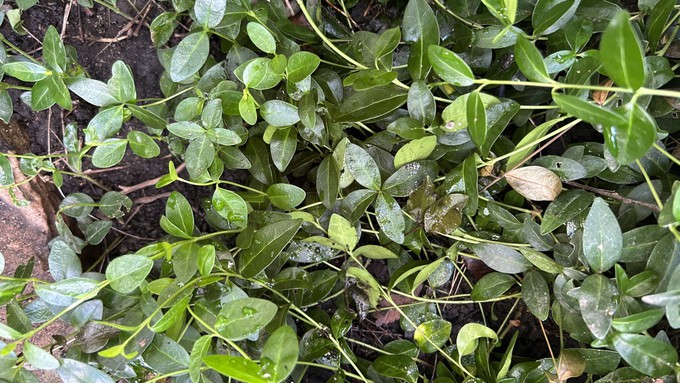
Raising awareness of these plants is a statewide effort

No flowers on it at the moment, but the matting tendency of Vinca major is obvious. Kathy Morrison
California gardeners with any experience likely have planted something that they've lived to regret. The tree that throws up suckers, the flowers that reseed too fully, the shrub that grows into a sticky, smelly mess. But at least these are confined disasters, which could be (probably should be) "shovel pruned."
The really dangerous plants are ones so vigorous that they can spread from gardens into open landscapes, pushing out native plants and causing ecological damage.
The worst of these infamous species are on a Do Not Plant List. They include such disasters as pampas grass, water hyacinth and highway iceplant. These botanical thugs are receiving some extra attention during California Invasive Species Week, which runs through Sunday.
PlantRight.Org, the California Invasive Plant Council (Cal-IPC) and the California Native Plant Society have pushed hard to persuade nurseries to stop selling these plants to landscapers and home gardeners. Officially, 15 of them are "retired," each one a victory for the state's ecosystem, but that doesn't mean these plants aren't still out there: Scotch broom and blue gum eucalyptus, for example, are still evident around California -- and add to fire fuel loads, meaning they're dangerous near homes.
Check out the PlantRight current list as well as the retirees. The list includes alternatives to plant that resemble the thugs but are either native or much better behaved.
Meanwhile, I'm going to work harder to get rid of that periwinkle (Vinca major, not the cultivars), which some previous resident planted in my back garden. Such a pretty little plant, but really nasty when it gets near streams, apparently. Here's what PlantRight says:
"Because periwinkle grows rampant in many California backyards, new populations of this plant also commonly spread from locations where yard waste is dumped."
And this: eek! "Periwinkle is a fast-growing, competitive plant that forms dense mats of growth. These mats crowd out other plants and degrade animal habitat in infested areas. Riparian areas are especially susceptible to periwinkle, where the far-flung vines crowd out native vegetation. It is also a known host to the bacterium that causes Pierce's disease, which is a deadly disease to grapevines."
Oh, yeah, it's gotta go.
Comments
0 comments have been posted.Sacramento Digs Gardening to your inbox.
Sites We Like
Garden Checklist for week of July 21
Your garden needs you!
* Keep your vegetable garden watered, mulched and weeded. Water before 8 a.m. to reduce the chance of fungal infection and to conserve moisture.
* Feed vegetable plants bone meal, rock phosphate or other fertilizers high in phosphate to stimulate more blooms and fruiting. (But wait until daily high temperatures drop out of the 100s.)
* Don’t let tomatoes wilt or dry out completely. Give tomatoes a deep watering two to three times a week.
* Harvest vegetables promptly to encourage plants to produce more. Squash especially tends to grow rapidly in hot weather. Keep an eye on zucchini.
* Pinch back chrysanthemums for bushy plants and more flowers in September.
* Remove spent flowers from roses, daylilies and other bloomers as they finish flowering.
* Pinch off blooms from basil so the plant will grow more leaves.
* Cut back lavender after flowering to promote a second bloom.
* It's not too late to add a splash of color. Plant petunias, snapdragons, zinnias and marigolds.
* From seed, plant corn, pumpkins, radishes, winter squash and sunflowers.